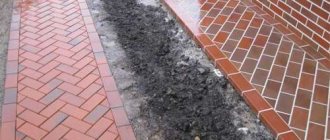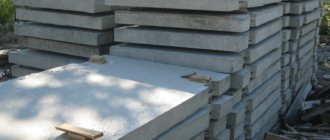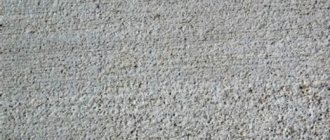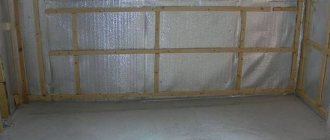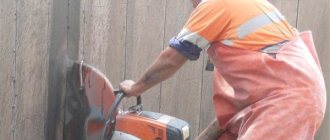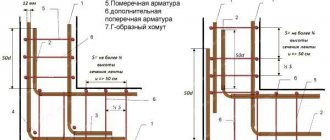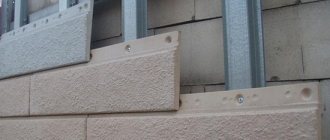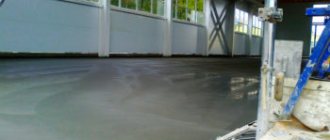Concrete for the construction of roads and airfields
The main feature of concrete, which is used for the construction of highway surfaces, runways and airfield taxiways, is the ability to withstand significant dynamic abrasive, compressive and bending mechanical loads for a long time, as well as the active aggressive influence of harmful atmospheric factors: temperature changes, increased importance, wind and freezing cycles - defrosting.
Therefore, concrete for road and airfield pavements must meet the following general characteristics:
- Compressive strength class: from B5 to B40 depending on specific operating conditions;
- Bending tensile strength class: from Btb1.2 to Btb4.0, also depending on specific climatic and other operating conditions;
- The strength and frost resistance of a concrete coating are also determined depending on the coating layer and climatic operating conditions. The oriented data are summarized in Table No. 1.
Table No. 1. Recommended basic characteristics of concrete for roads and airfields
| Average monthly air temperature range of the coldest month, degrees Celsius | Concrete frost resistance class, F | Compressive strength, MPa | Bending strength, MPa | Ratio: water-cement, no more |
| Material for single-layer and top layer of 2-layer coatings | ||||
| From 0 to minus 6 | 100 | From 30 to 55 | From 4 to 5.5 | 1/2 |
| From minus 6 to minus 10 | 150 | |||
| Below minus 15 | 200 | |||
| Material for the second layer of 2-layer coatings | ||||
| From 0 to minus 6 | 50 | From 25 to 35 | From 3.6 to 4.6 | 1/2 |
| Below minus 15 | 100 | |||
In accordance with the requirements of GOST 10178, for mixing concrete for road and airfield pavements, cement must be used based on materials containing tricalcium aluminate (C3A) in an amount of no more than 8% in clinker by weight.
In addition, for the production of such concrete it is recommended to use the following brands of Portland cement: M300, M400, M500. and M600. The last two grades are allowed for use with the simultaneous addition of granulated slag additives in a volume of no more than 15%. In this case, the calculated surface of cement with the addition of slag must be at least 2,800 cm2/kg.
Concrete for roads and airfields
The material for creating a load-bearing and contact layer on surfaces with a high level of loads is concrete for road and airfield pavements, which is classified as so-called “heavy” concrete. These compounds are designed to create conditions for efficient and durable operation of roads and runways. The peculiarity of objects of this type is the complex load profile.
The surface and base of the road, runway, and airfield taxiway experience a number of specific loads. The picture here is not at all similar to the one that develops when using a monolith or reinforced concrete part in a volumetric structure or building, regardless of its purpose. Concrete from the manufacturer must have special characteristics that allow it to overcome the emerging limitations and difficulties.
Features of roads, runways and airfields
A characteristic feature of transport objects directly related to the movement of heavy equipment is the peculiarities of the interaction of surfaces with the chassis, the nature and loading profile of the canvas:
- unlike building structures, monolithic parts of the canvas experience dynamic loads, and situations often arise when these stresses arise unevenly over a short time;
- the requirements for tensile strength of concrete are increasing;
- the nature of the compression of the slabs and the layer of fabric has signs of localization of loads along the axes with limited force in the interaxle sector;
- uneven distribution of forces can cause deformation of the monolith and slab;
- Of great importance is the ability of the monolith to resist freezing and penetration of water, which is especially important in the conditions of the North or regions with severely frosty winters and significant temperature changes.
In industrial conditions, concrete production allows you to create solutions that meet increased requirements for composition, fillers and cement.
Types of concrete pavement and its features
Laying a concrete road and runway requires very careful adherence to technology. Deviations from technological maps, typical of many of our builders, can have the effect of quickly rendering the canvas unusable, although it is quite capable of serving up to 25 years without the need for major repairs. The design features of such a “pie” are the different types of solution that forms each of the layers.
Bottom layer of concrete
A high-strength road surface contains a bottom layer of concrete grade M250 - M350, which must withstand a tensile load with a tensile strength of 35 - 45 and undergo at least 50 freezing cycles, and in areas where temperatures drop below -15 C, up to 100 cycles.
Top layer of concrete
The second (top) layer of the concrete road is made of concrete M300 - M400 - M500 with a tensile load in the range of 40 - 55 and frost resistance from 100 to 200 cycles. The same standards apply to road surfaces in single-layer structures.
Cement concrete coating
A high-quality finishing coating for roads is a cement-concrete mixture in which cement, unlike asphalt, plays the role of a binder. At the stage of its formation, special attention is paid to leveling and creating notches on the finished canvas. The widely known misconception regarding the greater “noisiness” of concrete routes has a known origin. This is the use of a transverse notch. After the introduction of longitudinal groove technology, the noise level from roads of this type has decreased significantly.
The base of the concrete roadway is laid in such a way that the solution does not have time to settle. If the larger components of the mixture settle down, after a short time the monolith will delaminate and the geotextile lining will lose its effectiveness. A damaged and incorrectly laid concrete road is immediately noticeable - it is a continuous chain of puddles, since the water does not go into the base, as on asphalt and asphalt concrete surfaces.
Disadvantages and prospects of concrete roads
While there is practically no alternative for concrete runways in large aviation hubs, road construction using this technology is poorly developed in Russia. There are several reasons for this, but the main one remains - these are strict technological requirements, violation of which threatens with very high costs and irreparable losses.
The concrete road surface, once laid and put into operation, has several features:
- the road limits the possibilities of repair as much as possible, especially pothole repair, so any consequences of process violations will be fatal for a large area;
- it is almost impossible to carry out repairs locally; it is necessary to literally cut out large areas, replacing them with new ones;
- construction and restoration of the road surface require many times more time compared to asphalt roads - if the latter can be used within 12-24 hours after laying the surface, then the period for concrete to gain strength is at least 8 days;
- The contractor’s willingness to work under conditions of strict technological discipline is limited to the supply of high-quality mortar - not all concrete producers are ready to comply with the requirements.
The process of laying the canvas today is more complicated than working with asphalt - after it has gained strength, it is necessary to cut thermal expansion joints and seal them with special gaskets, which takes time from the final contractor. The situation is that the high quality and reliability of the solution is sacrificed for the fear of incurring high costs without guaranteeing reliability.
Operational practice shows that concrete single-layer monoliths and double-layer roads ultimately provide opportunities to save money on subsequent repairs and maintaining their working condition. The increase in the turnaround time from 8-12 to 24 years alone is direct evidence of this effect. It's a matter of willingness to comply with technological requirements and proceed from the long-term perspective of economic feasibility.
erkon-beton.ru
Aggregate characteristics
As a fine aggregate, it is allowed to use natural sand with a clay and dust content of no more than 2%, or artificial sand with a content of these harmful factors of no more than 5%.
The strength of the main aggregate (crushed stone) used for pouring single-layer coatings and the top layer of double-layer coatings must correspond to 120 MPa, and for concrete for pouring the bottom layer of double-layer coatings, at least 80-60 MPa. The maximum grain size of crushed stone for pouring the top layer of two-layer coatings is no more than 25 mm, for single-layer and the bottom layer of two-layer coatings is no more than 40 mm, and for base concrete is no more than 70 mm.
To increase the quality of concrete and its resistance to harmful atmospheric and other factors, special surfactant additives are introduced into the material. In this case, the degree of workability is assigned within the following limits:
- When using a concrete paver on a wheel-rail traction – Cone settlement ≤ 2 cm (W ≥ 8 s);
- When using a concrete paver with sliding formwork – Cone settlement ≤ 2…4 cm (W ≥ 5…10 s);
- When using conventional vibrators and vibrating slats – Cone draft ≤ 4 cm.
When laying road and airfield surfaces, it is very important to comply with the conditions for proper curing of concrete, using film protective materials for these purposes.
Road concrete
Concrete is the most popular building material because, depending on its composition, it can be used in almost any field. This factor determines versatility, which is considered one of the main advantages. Road concrete should be included in a separate group . They are used when it is necessary to build road surfaces, as well as airfield pavement. A distinctive feature is operation in rather difficult conditions. The material is subject to regular loads of several tons. To ensure minimal costs, road concrete must have high performance characteristics that guarantee durability. Compliance with the established recipe plays a big role in the cooking process. The composition of road concrete, as well as features and recommendations for its operation are prescribed in GOST 10268-80. The requirements for the mixture depend on the specific area in which it will be used:
- For creating single-layer coatings, as well as the top layer of multi-layer options. In this case, the requirements are maximum, since not only loads from transport are affected, but also from the external environment. This leads to severe and accelerated wear.
- For the bottom layer in cases where a two-layer coating is used. This option allows you to pay less attention to the characteristics, which has a positive effect on the cost. Additionally, most environmental impacts are eliminated.
- As a base for an improved type of capital covering. This option implies fairly average performance indicators for the road concrete used.
GOST 10268-80 establishes the need to introduce additives to obtain a specific frost resistance indicator. It should be noted that the required amount depends on the type of climate zone in which the mixture is laid. At the same time, the outer layer must have a frost resistance of at least 150 units. If we consider road concrete as a whole, it is a type of heavy concrete. To prepare a high-quality and durable mixture, the grade of cement must be no lower than M300 for foundations and M400 for all other types of work. The more rolling stock is used to create road concrete, the lower its resistance to wear during operation will be. Another factor that has a negative impact on this parameter is hardening under low temperature conditions.
Road concrete
are subject not only to regular loads from vehicles passing along the roadway, but can also often be filled with water, for example, during prolonged rains or melting snow. This is one of the main reasons why this type of artificial stone is classified into a separate subclass.
Only a high-strength coating that is not afraid of regular “baths” and also withstands the effects of sudden temperature changes can be used in the construction of large highways.
There are several main characteristics that distinguish road concrete
from other compounds:
- The level of microcrack formation is a fairly important indicator, since road work is often carried out under rather unfavorable conditions, therefore, the risk of microscopic damage to the structure is quite high during the entire hardening process of the material.
- Tensile strength. Road concrete
differ from conventional ones in that a significant part of the load is due not so much to compression as to tension, therefore this characteristic is one of the determining ones when choosing a particular composition.
- Resistance to dynamic influences allows artificial stone to withstand regular vibration created when a large number of vehicles pass along the highway.
- Another feature that distinguishes road concrete
– a certain level of chemical resistance. It is no secret that reagents that are quite harmful to building materials are often used to remove ice from the surface of highways, but modern developments can easily cope with such effects.
Many experts use a complex indicator, such as a combination of strength and frost resistance. It is convenient because it allows you to determine the maximum operating time of the canvas. The higher this characteristic, the lower the cost of various repairs. The tensile capacity of concrete depends on many different factors, so choosing the right ready-mix supplier is important. In order for road concrete
received the necessary set of characteristics, special additives are widely used. Resistance under aggressive conditions is increased due to the introduction of polymer substances that have a positive effect on increasing the strength of the material.
Increasing resistance to dynamic loads required the use of fiberglass, which provides additional reinforcement to the material. Modern road concrete
- not just an artificial stone, but a high-strength composite, characterized by high strength and reliability. Fiber also allows us to solve such a problem as increasing the wear resistance of the material, which is quite important these days for large highways. To obtain road concrete with optimal characteristics, it is recommended to adhere to a water-cement ratio of 0.5 for surface layers, as well as 0.6 for lower and intermediate options. If a base is laid, the water to cement ratio should not exceed 0.75. GOST 10268-80 sets the maximum diameters of filler particles. For the top layer they should not exceed 20 mm, and for the bottom - 40.
It is obvious that only an integrated approach allowed manufacturers to achieve high results. road concrete is also available in Russia.
, which are used to lay highways in EU countries.
